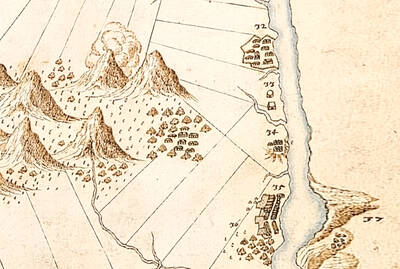Japanese pop princess Noriko Sakai’s ongoing drug scandal took a turn for the worse when the disgraced actress’ vacation home in Katsuura, Chiba Prefecture, was gutted by a fire early on Sunday. According to the Liberty Times (the Taipei Times’ sister newspaper) the police suspect arson, and speculation immediately arose that the fire was set to destroy evidence because the house was reportedly one of the spots where Sakai and her husband Yuichi Takaso kept their stash.
Sakai made a tearful apology for using drugs at a press conference that lasted 10 minutes but drew massive media interest after she was released on bail on Thursday of last week. The 38-year-old actress was admitted to a Tokyo hospital shortly afterwards. A troupe of black-clad bodyguards is said to be keeping Sakai safe after threatening messages circulated on the Internet.
Meanwhile, a Taiwanese entertainment company has reportedly invited Sakai to revive her career in Taiwan. The news prompted sarcastic reports in the Japanese media, which commented that Taiwan’s entertainment industry has seen so many scandals that it has been inured to them.
Unless, of course, there’s an “ABC” involved. Former Channel V presenter Henry Lu (呂良基) was arrested this week for marijuana possession along with six other suspects, most of whom grew up in either Canada, Australia or the US.
Given the way it has been used in coverage of the arrests, ABC, which means American-born Chinese in English, has a different meaning in Chinese, as in the TTV headline Police Close in From Three Directions, Tianmu, Neihu and Taichung, Arrested Six People, All ABCs From Foreign Countries (警方兵分三路,從天母、內湖以及台中,逮捕六人,他們清一色都是從國外回來的ABC).
Intrepid journalists have been quick to point out the correlation between drug use and having been born or studied abroad.
Elva Hsiao (蕭亞軒) and Fan Fan (范瑋琪) were both interviewed for what ended up being a front-page anti-drug report in the Liberty Times.
And going one better than former US president Bill Clinton (who claims he pretended to smoke a joint but “didn’t inhale”), perhaps in an effort to protect themselves in the event that the fuzz decides to play another round of Celebrity Drug Bust, singer and wannabee director David Tao (陶吉吉) and pop idol Mark Chao (趙又廷) both volunteered information that they had involuntarily inhaled “secondhand marijuana” smoke (二手麻).
In other news, variety show host Chang Fei (張菲), who as far as Pop Stop knows isn’t a stoner but certainly looks like one, has wasted no time in putting the moves on Monique Lin (林慧萍), a popular singer in the 1980s who was divorced a couple of weeks ago.
The sunglasses-wearing, Bee Gees-bouffanted Chang, who dated Lin for five years, threw his hat into the ring by telling gossip journos he was happy to hear the news.
“I am ready. Now it is up to her to make the decision,” Chang said when asked on Tuesday if he wanted to have another go at Lin.
Another entertainer with a unique appearance, veteran show hostess Chen Chin-pei (陳今佩) better known as the Great White Shark (大白鯊) for her formerly generous physique, has returned to showbiz after slimming down from 120kg to 69kg in 11 months.
The 57-year-old was spotted by local paparazzi chatting with friends and her boyfriend at a coffee shop in Taipei’s East District (東區) last week.
Always vigilant when it comes to older women dating younger men, Apple Daily reports that Chen’s boyfriend, known as “Alex” to the media, is 29 years her junior, and is one of the reasons why the entertainer lost so much weight. Apparently there are two other reasons: a pair of younger paramours in China.
The press has even given Chen a new nickname, “shar-pei,” or dog face (沙皮臉). This is because one of the side effects of losing so much weight so quickly is saggy skin. The Not-So-Big Shark said she would get that problem sorted out before making a comeback.

The Nuremberg trials have inspired filmmakers before, from Stanley Kramer’s 1961 drama to the 2000 television miniseries with Alec Baldwin and Brian Cox. But for the latest take, Nuremberg, writer-director James Vanderbilt focuses on a lesser-known figure: The US Army psychiatrist Douglas Kelley, who after the war was assigned to supervise and evaluate captured Nazi leaders to ensure they were fit for trial (and also keep them alive). But his is a name that had been largely forgotten: He wasn’t even a character in the miniseries. Kelley, portrayed in the film by Rami Malek, was an ambitious sort who saw in

Last week gave us the droll little comedy of People’s Republic of China’s (PRC) consul general in Osaka posting a threat on X in response to Japanese Prime Minister Sanae Takaichi saying to the Diet that a Chinese attack on Taiwan may be an “existential threat” to Japan. That would allow Japanese Self Defence Forces to respond militarily. The PRC representative then said that if a “filthy neck sticks itself in uninvited, we will cut it off without a moment’s hesitation. Are you prepared for that?” This was widely, and probably deliberately, construed as a threat to behead Takaichi, though it

Among the Nazis who were prosecuted during the Nuremberg trials in 1945 and 1946 was Hitler’s second-in-command, Hermann Goring. Less widely known, though, is the involvement of the US psychiatrist Douglas Kelley, who spent more than 80 hours interviewing and assessing Goring and 21 other Nazi officials prior to the trials. As described in Jack El-Hai’s 2013 book The Nazi and the Psychiatrist, Kelley was charmed by Goring but also haunted by his own conclusion that the Nazis’ atrocities were not specific to that time and place or to those people: they could in fact happen anywhere. He was ultimately

Nov. 17 to Nov. 23 When Kanori Ino surveyed Taipei’s Indigenous settlements in 1896, he found a culture that was fading. Although there was still a “clear line of distinction” between the Ketagalan people and the neighboring Han settlers that had been arriving over the previous 200 years, the former had largely adopted the customs and language of the latter. “Fortunately, some elders still remember their past customs and language. But if we do not hurry and record them now, future researchers will have nothing left but to weep amid the ruins of Indigenous settlements,” he wrote in the Journal of